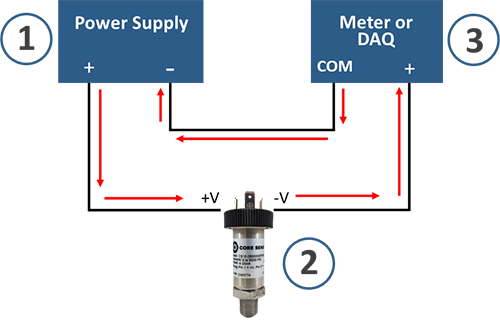2-wire loop powered
The 4-20mA output signal is an analog output signal commonly used in sensors. It is typically powered by DC voltage ranging from 8-32 VDC, which are widely available commercially.
Occasionally, 4-20mA output signals use a three wire configuration (+V, -V, +S), but the vast majority of modern 4-20mA output sensors employ a two-wire, loop powered configuration with a supply (+V) and ground (-V). The current (mA) is measured on the loop by reading the voltage across a known value resistor (often called a sense resistor).
Nearly all industrial level products from Core Sensors offer 4-20mA output options.
Output Signal
4-20mA two wire, loop-powered
Excitation Voltage
10-28VDC
4-20mA Wiring Schematic – How To Guide
For this how to guide, there are three components; power supply, Core Sensors pressure transducer, and a meter or other DAQ system.
1) Power Supply – The first component to the current loop is the power supply, capable of delivering 10-28VDC. The positive (+) terminal of the power supply is connected to the +V pin or wire of the transducer.
2) Core Sensors Pressure Transducer – The -V pin or wire of the transducer is connected to the milliamp input terminal of the meter or DAQ.
3) Meter or other data acquisition (DAQ) – The Common (COM) terminal of the meter or DAQ is then connected to the negative (-) terminal of the power supply. This final step is important as it completes the current loop.
* In certain circumstances, there may be an additional pin or wire used as a case ground. This connection is not critical to the current loop but may be critical to maintain listed certifications of the transducer. Please refer to the Core Sensors wiring guides to verify wiring prior to installation.

Advantages
- Noise Immunity
- No signal loss over long transmission distances
- Compatibility with various power supplies and PLC’s because of high usage in general industry
Disadvantages
- Current consumption is high when compared to a voltage output sensor
- Need for at least 10VDC excitation, making for limited battery-powered options